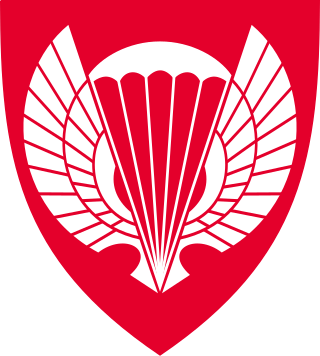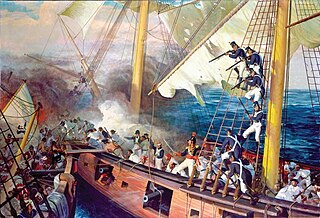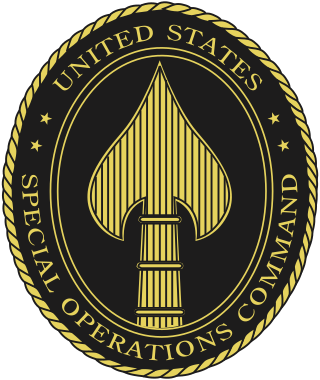The United States Armed Forces are the military forces of the United States. The armed forces consist of six service branches: the Army, Marine Corps, Navy, Air Force, Space Force, and Coast Guard. All six armed services are among the eight uniformed services of the United States.

The Royal Norwegian Navy is the branch of the Norwegian Armed Forces responsible for naval operations of Norway, including those of the Norwegian Coast Guard. As of 2008, the Royal Norwegian Navy consists of approximately 3,700 personnel and 70 vessels, including 4 heavy frigates, 6 submarines, 14 patrol boats, 4 minesweepers, 4 minehunters, 1 mine detection vessel, 4 support vessels and 2 training vessels.

Jäger is a German military term referring to specific light infantry units.

The Norwegian Armed Forces is the military organization responsible for the defence of Norway. It consists of five branches, the Norwegian Army, the Royal Norwegian Navy, which includes the Coast Guard, the Royal Norwegian Air Force, the Home Guard, and Norwegian Cyber Defence Force as well as several joint departments.

Marinejegerkommandoen (MJK) is the maritime/naval special warfare unit of the Norwegian Armed Forces and was established in 1953.

The 2nd Battalion is an infantry unit of the Norwegian Army, based at camp Skjold in Troms county in Northern Norway. It serves in the light infantry role specialized in Arctic warfare as part of Brigade Nord; the battalion is one of three manoeuvre battalions within the brigade, along with Telemark Battalion and Panserbataljonen. The 2nd Battalion serves two roles, primarily being organised for domestic defence; however, during Norway's contribution to the NATO forces in Afghanistan, the 2nd Battalion played a vital role. The 2nd Battalion also contributed consistently to the ISAF forces in northern Afghanistan, supporting an elite trained light infantry, organized as a Quick Reaction Force (QRF). The battalion is divided into four companies: Bravo company, Charlie company, the cavalry squadron and the support company. Bravo company and Charlie company serves as specialized light infantry, focusing on Arctic warfare and urban warfare. The cavalry squadron is the battalion's internal intelligence unit as well as consisting of one platoon of marksmen. The support company is the largest of the four, and primarily consists of medics, anti-tank personnel, combat, service and support. The battalion uses a khaki beret, as opposed to the traditional black beret worn by cavalry units throughout the world, which symbolizes the battalion's history.

The Frogman Corps is the maritime special operations force of the Danish Armed Forces part of Special Operations Command. On 1 July 2015, the Frogman Corps transferred from the Royal Danish Navy to the newly established Special Operations Command.

Hærens Jegerkommando (HJK) was a special forces unit of the Norwegian military. It was the armed forces competence centre for commando, airborne and counter terrorist duty in the Norwegian Army. Its headquarters were located 30 kilometres north of Elverum in the southeast of Norway, at Rena leir military base. In 2006, the unit was merged with Forsvarets Spesialkommando/Special Operations Commando.

Marines, or naval infantry, are soldiers who specialise at operating in littoral zones, both on land and at sea. Historically, the main tasks undertaken by marines have included raiding ashore in support of naval objectives, and the boarding of vessels during combat or capture of prize ships. Marines also help maintain discipline and order aboard the ship. In most countries, marines are an integral part of that state's navy.

Forsvarets Spesialkommando (FSK) is a special operations forces unit of the Norwegian Special Operation Forces. The unit was established in 1982 due to the increased risk of terrorist activity against Norwegian interests, including the oil platforms in the North Sea.

Minedykkerkommandoen (MDK) or Norwegian Naval EOD Command is a clearance diver group. MDK is subordinate to the Royal Norwegian Navy. MDK is located at Haakonsvern Naval Base in Bergen and Ramsund Naval Base, in vicinity of Harstad.

The Special Actions Detachment or DAE is the tier one special force maritime unit of the Portuguese Navy. It is part of the Portuguese Marine Corps. Raised in 1985, the DAE is one of the smallest special forces units within the Portuguese Armed Forces. It is responsible for conducting air-sea rescue, amphibious reconnaissance, amphibious warfare, black operation, bomb disposal, CBRN defense, coastal raiding, counterterrorism, direct action, executive protection, hostage rescue, irregular warfare, ISTAR, long-range penetration, JTAC, manhunt high-value target, maritime sabotage, mountain rescue, naval boarding, operation behind high risk enemy lines, special operations, special reconnaissance, tracking targets, underwater demolition, unconventional warfare, other missions in support of Portuguese and NATO armed forces. DAE's mission and training are similar to American special forces and it often trains with them.

Following the terrorist attacks of September 11, 2001, several nations took on Al-Qaeda and the Taliban during Operation Enduring Freedom (OEF) in Afghanistan. OEF was the initial combat operations starting on 7 October 2001, in the wake of the 11 September attacks on the United States, and during 2002 and 2003.

In January 2006, NATO's focus in southern Afghanistan was to form Provincial Reconstruction Teams with the British leading in Helmand Province and the Netherlands, Australia and Canada leading similar deployments in Orūzgān Province and Kandahar Province respectively. The United States, with 2,200 troops, stayed in control of Zabul Province. Local Taliban figures voiced opposition to the incoming force and pledged to resist it.

The 202nd Coastal Ranger Company is an amphibious special operations capable ranger unit within the Swedish Amphibious Corps, which is the maritime land force arm of the Swedish Navy.

The US employs divers in several branches of the armed forces, including the navy, army, marines, air force and coast guard.

The United States Special Operations Command is the unified combatant command charged with overseeing the various special operations component commands of the Army, Marine Corps, Navy, and Air Force of the United States Armed Forces. The command is part of the Department of Defense and is the only unified combatant command created by an Act of Congress. USSOCOM is headquartered at MacDill Air Force Base in Tampa, Florida.
Jegertroppen is an all female special operations forces unit of the Special Operations Commando (FSK) of the Norwegian Special Operation Forces (NORSOF).

The Ops-Core Future Assault Shell Technology (FAST) Helmet, also known as the FAST helmet, is an American combat helmet used by special operations forces and law enforcement organizations in various countries, as well as the current standard protective headgear of the Norwegian Armed Forces.


















